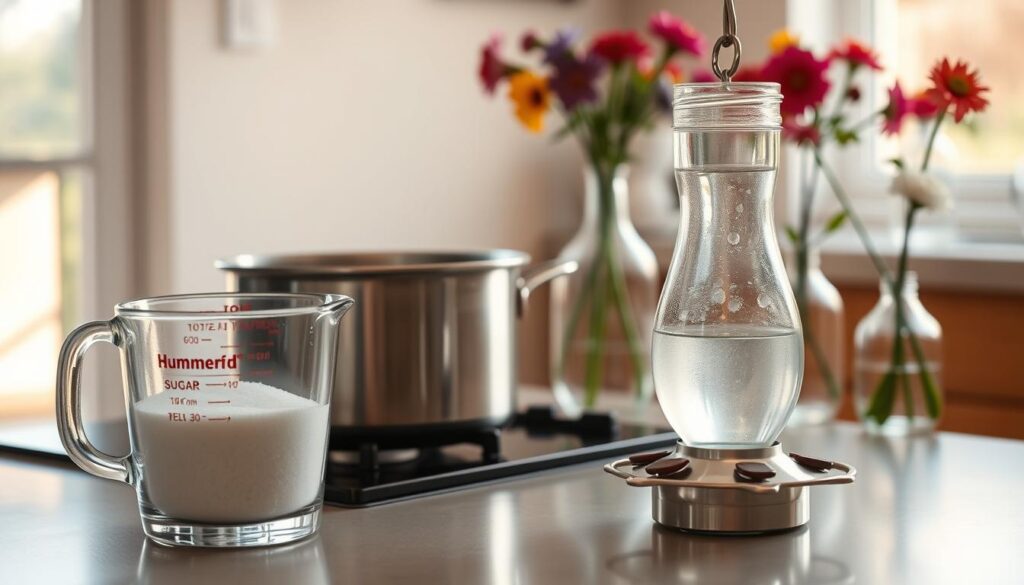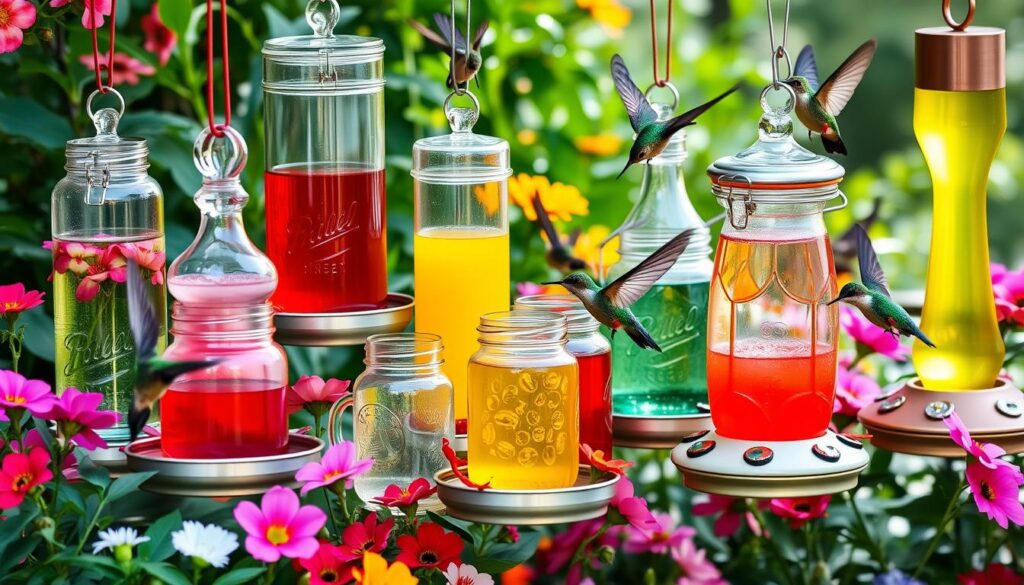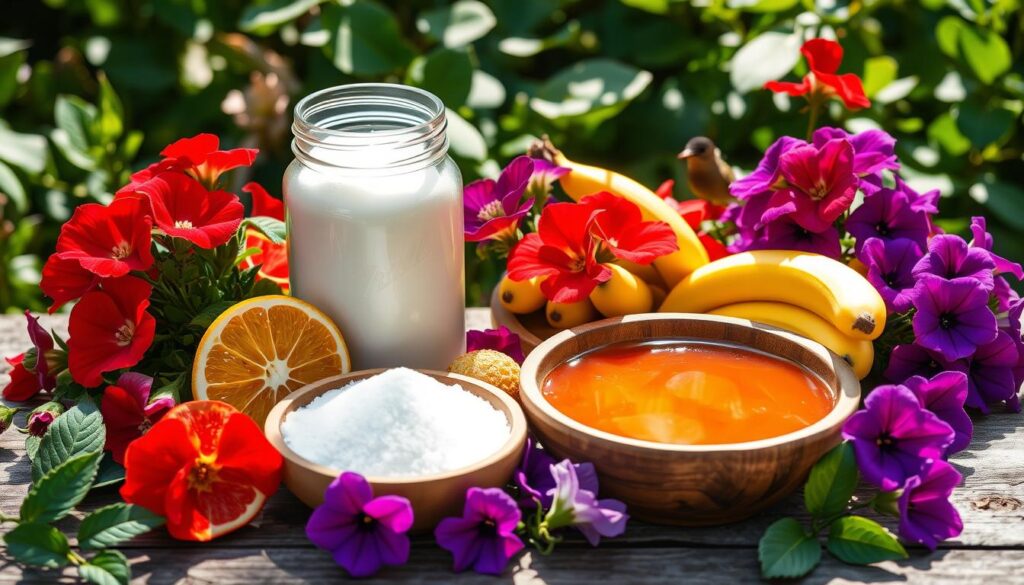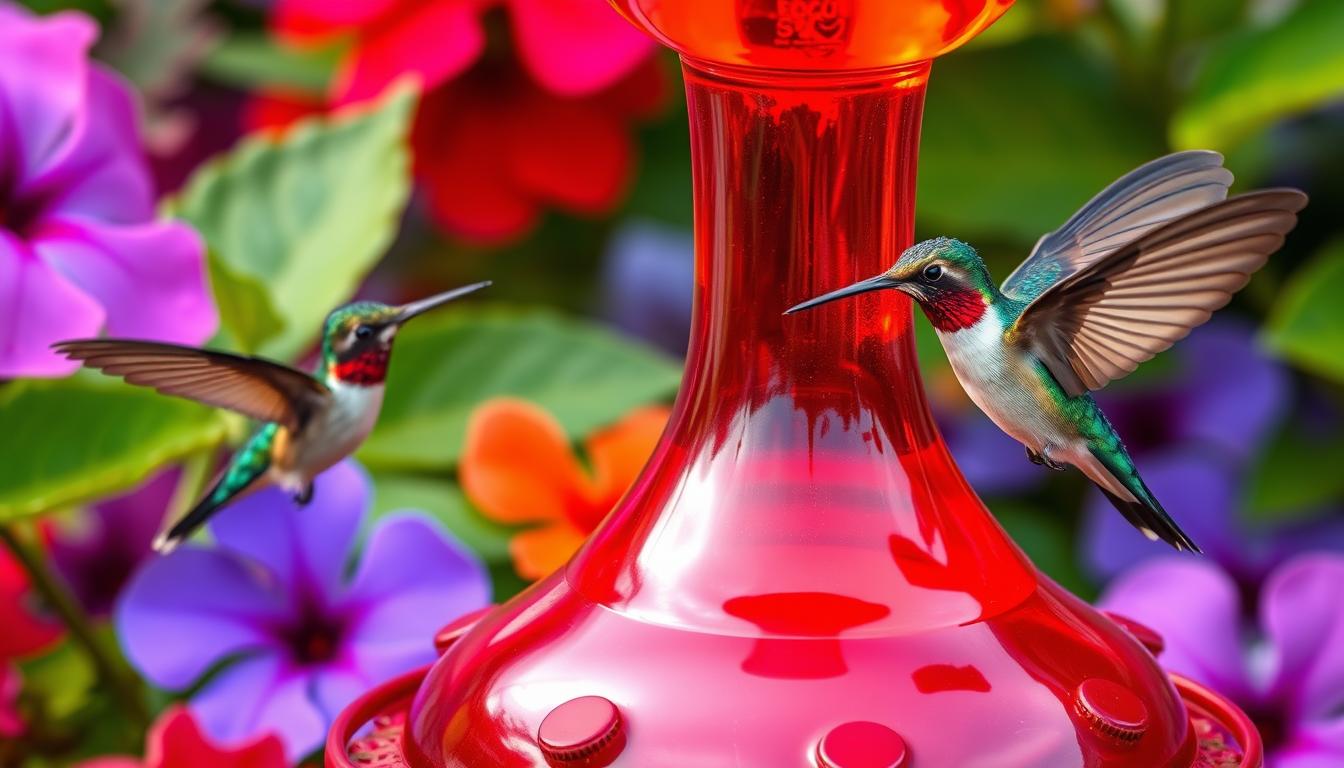To attract hummingbirds, you need to offer the right food. Hummingbird food is key to a bird-friendly yard. A tasty and healthy diet will draw these birds to your space. They love yards with a steady food supply, like homemade or store-bought nectar.
To make a hummingbird-friendly yard, know what they eat. They need lots of sugar to keep their energy up. You can make a homemade food mix with sugar and water. This will attract these stunning birds to your yard.
Key Takeaways
- Provide hummingbirds with a reliable source of food to attract them to your yard
- Hummingbird food should be rich in sugar to fuel their high metabolism
- Homemade hummingbird food is a cost-effective and easy way to attract hummingbirds
- Attract hummingbirds with a simple recipe that includes sugar and water
- Creating a hummingbird-friendly backyard requires some knowledge of their dietary needs
- Hummingbirds are attracted to yards that offer a reliable source of hummingbird food
- Offering the right food can help you enjoy the beautiful presence of hummingbirds in your yard
Understanding Hummingbird Dietary Needs
Hummingbirds need specific foods to stay healthy and visit your backyard. They mainly eat nectar, a sweet liquid from flowers. To make a great hummingbird food mix, knowing their natural foods, nectar needs, and when to feed them is key.
In the wild, they drink nectar from flowers like honeysuckle and fuchsia. They also eat small insects and spiders for protein. For best hummingbird food, a sugar and water mix is good. But, it’s important to get the sugar and water ratio right to match flower nectar.
Natural Food Sources for Hummingbirds
Some natural foods for hummingbirds include:
- Trumpet-shaped flowers like honeysuckle and fuchsia
- Tubular flowers like salvias and coral bells
- Small insects like aphids and whiteflies
- Spiders and other small arachnids
Daily Nectar Requirements
Hummingbirds need a lot of energy. Their nectar needs change with the weather, temperature, and how active they are. On average, they drink 2-3 times their body weight in nectar daily.
The Perfect Hummingbird Food Recipe
Making a tasty homemade hummingbird food is more than just mixing sugar and water. A great hummingbird food recipe is key to drawing these lovely birds to your garden. It’s important to pick the right sugar, use clean water, and get the sugar-to-water ratio just right.
A basic hummingbird food recipe has four parts water to one part sugar. This mix is close to the nectar in flowers. Making your own homemade hummingbird food lets you control what goes in and keeps your birds safe from bad stuff in store-bought foods.
Here are some important tips for your hummingbird food recipe:
- Choose pure cane sugar, as it’s better for hummingbirds to digest.
- Stay away from artificial sweeteners or honey, as they can hurt the birds.
- Use fresh, filtered water to stop bacteria from growing.
By following these easy tips and using a good hummingbird food recipe, you can make a yummy and healthy homemade hummingbird food. This will attract these stunning birds to your yard and keep them coming back.
Essential Ingredients for Making Hummingbird Food
Choosing the right ingredients is key when making hummingbird food. These ingredients must be natural to keep the birds healthy. A mix of sugar and water is common, but the type of sugar and water quality matter a lot.
Choosing the Right Sugar Type
It’s important to pick the right sugar for hummingbird food. White granulated sugar is best because it’s easy for birds to digest. Honey, artificial sweeteners, and red dye are bad for them and should be avoided.
Water Quality Requirements
Water quality is also crucial. Use fresh, filtered water to keep the birds healthy. Tap water can have chemicals or minerals that harm them.
Ingredients to Avoid
There are some ingredients you should not use in hummingbird food. Artificial sweeteners, honey, and red dye can be harmful. By sticking to natural ingredients, you can make a safe and tasty food for hummingbirds.
| Ingredient | Recommended | Not Recommended |
|---|---|---|
| Sugar | White granulated sugar | Honey, artificial sweeteners |
| Water | Fresh, filtered water | Tap water |
Step-by-Step Nectar Preparation Guide
To make the best hummingbird food, follow a simple recipe and preparation process. Hummingbird food, or nectar, is a mix of sugar and water. It gives these birds the energy they need to thrive.
When making nectar, it’s key to use the right sugar to water ratio. This ensures the hummingbirds get the nutrients they need. The basic recipe is a 4:1 ratio of water to sugar.
This means for every one part of sugar, use four parts of water. For example, use one cup of sugar and four cups of water. This ratio helps prevent spoilage and keeps the nectar safe for hummingbirds.
Here’s a step-by-step guide to prepare the best hummingbird food:
- Boil the water to prevent bacterial growth and ensure the nectar is safe for the hummingbirds.
- Mix the sugar and water together until the sugar is completely dissolved.
- Let the mixture cool before filling your hummingbird feeder.
- Store any leftover nectar in the refrigerator to prevent spoilage.

By following these simple steps, you can create a nutritious and delicious hummingbird food. This will attract these beautiful birds to your yard. Always use fresh ingredients and clean your feeder regularly to keep the hummingbirds healthy.
Commercial vs Homemade Hummingbird Food
Deciding between commercial and homemade hummingbird food is crucial. Homemade food is cost-effective and can be tailored to your needs. Commercial food, however, is easy to find and convenient.
Cost is a big factor. Homemade food, made from sugar and water, is often cheaper. Yet, some might find commercial food’s ease of use worth the extra cost. It’s important to compare prices and find the best deal.
Cost Comparison
- Homemade hummingbird food: $0.50 per quart
- Commercial hummingbird food: $2.00 per quart
Commercial food is more convenient, available at pet stores and online. Homemade food, while requiring prep time, can be made in bulk and stored. Online, you can find many commercial options.
Quality Considerations
Quality of ingredients matters. Homemade food can use pure cane sugar, better for hummingbirds than refined sugar in some commercial products. It also allows for customization based on your local hummingbirds’ needs.
Your choice between commercial and homemade food depends on your preferences and needs. Consider cost, convenience, and quality. Whether making your own or buying, research to find the best option for your hummingbirds.
Selecting the Best Hummingbird Feeders
To attract hummingbirds, picking the right feeder is key. The feeder’s size, material, and design matter a lot. A small feeder might not hold enough food. A big one can be hard to clean.
Look for easy-to-clean designs, durable materials, and ant moats. These features keep pests out. Feeders with bee guards also help keep bees away. Here are some tips for choosing the best feeder:
- Go for a feeder made for hummingbirds. They attract these birds best.
- Think about the hummingbird food you’ll use. Some feeders are for sugar-water, others for commercial nectar.
- Consider where you’ll put the feeder. Some are better for hanging, others for tables or railings.
Proper Feeder Placement Strategies
To attract hummingbirds, place your feeders wisely. Think about the best hanging heights, keeping them safe from predators, and far from windows. Homemade hummingbird food makes your yard a welcoming spot for these birds.
Choosing the right height for your feeders is key. Hang them between 3 to 5 feet off the ground. This makes it easy for hummingbirds to feed and keeps them safe from predators. For tips on making your yard bird-friendly, check out petsrelax.com.
Protection from Predators
Use feeders with ant moats or bee guards to keep predators away. These features stop ants and bees from getting to the food. Also, keep feeders at least 10 feet from buildings to keep cats and squirrels out.
Distance from Windows
Make sure feeders are far from windows to avoid bird crashes. A safe distance is at least 3 feet. By following these tips, you can make a safe space for hummingbirds to enjoy your homemade food.
- Hang feeders between 3 to 5 feet off the ground
- Use feeders with built-in ant moats or bee guards
- Place feeders at least 10 feet away from any structures
- Keep feeders at least 3 feet away from windows
Maintaining Clean Feeding Stations
To keep your hummingbird food fresh and prevent disease, clean feeding stations are key. Clean the feeders often, use the right cleaning solutions, and stop mold and bacteria. For more tips on feeding hummingbirds, check out hummingbird feeding tips.
Here are some tips to keep your feeding stations clean:
- Use a mix of water and white vinegar to clean the feeders.
- Avoid harsh chemicals or soap, as they can harm hummingbirds.
- Replace the best hummingbird food every 3-5 days to stop mold and bacteria.
By following these tips, you can keep your hummingbirds healthy and happy. Always use fresh hummingbird food and clean feeders to attract these beautiful birds to your yard.

Regular cleaning and maintenance of your feeders prevent disease spread and keep hummingbirds healthy. Use the right cleaning solutions and replace the best hummingbird food often. This way, you create a safe and welcoming space for these amazing birds.
Signs Your Hummingbird Food Has Gone Bad
When you make your own hummingbird food, it’s key to store it right to avoid spoilage. Natural hummingbird food can get moldy, ferment, or grow harmful bacteria if not stored properly.
To keep hummingbirds safe, it’s important to know when the food has gone bad. Here are some signs to watch for:
Visual Indicators
- Cloudy or discolored liquid
- Mold or fungus growth
- Slime or sediment at the bottom of the feeder
Recommended Storage Methods
To keep your homemade hummingbird food fresh, store it in the fridge at a temperature under 40°F (4°C). You can also freeze it for up to 2 months. Use an airtight container or freezer bag to freeze it to prevent contamination.
By using these storage tips and watching for signs of bad food, you can keep your feeder clean and safe. Always use fresh, natural hummingbird food to attract these lovely birds to your yard.
| Storage Method | Shelf Life |
|---|---|
| Refrigeration | Up to 5 days |
| Freezing | Up to 2 months |
Seasonal Feeding Adjustments
To attract hummingbirds to your yard, you need to change how you feed them with the seasons. Hummingbirds eat differently at different times of the year. Knowing this helps you give them the best hummingbird food.
In spring and summer, hummingbirds need a strong hummingbird food mix. Mix four parts water with one part sugar. In fall and winter, use six parts water to one part sugar.
Also, think about the flowers and plants that attract hummingbirds in each season. For example, in spring, they love flowers with lots of nectar, like trumpet-shaped ones and red salvia.
- Place feeders in areas with partial shade to full sun, depending on the season.
- Use feeders with built-in ant moats to keep ants out of the hummingbird food.
- Switch to different feeders, like from hanging to pole-mounted, for different hummingbirds.
Common Mistakes to Avoid When Feeding Hummingbirds
Feeding hummingbirds can be very rewarding. But, it’s important to avoid mistakes that can harm them. One big mistake is using the wrong sugar in your homemade hummingbird food. Honey or brown sugar can ferment and cause mold.
Another mistake is not cleaning the feeders often. This can lead to bacteria and mold growth. It’s key to use the best hummingbird food and keep the feeders clean for their health.
Some common mistakes to avoid when feeding hummingbirds include:
- Not using the right type of sugar in your homemade hummingbird food
- Not cleaning the feeders regularly
- Leaving feeders out during cold nights
- Forgetting to clean feeders regularly
- Setting out only one feeder, as hummingbirds can be territorial
By avoiding these mistakes and using the right food, like homemade hummingbird food, you can make your backyard a welcoming place for hummingbirds. Enjoy their beauty in your own backyard.
Natural Supplements to Hummingbird Food
Nectar is key for hummingbirds, but they need more for health. Adding fruit, pollen, and insects to natural hummingbird food boosts its value. These extras give vital vitamins and minerals.
To make your own hummingbird food, start with nectar. Then, add fresh fruit like oranges or grapefruits. Pollen is great too, offering protein and nutrients. You can also include insects like mealworms for protein.
Some natural supplements to think about are:
- Fresh fruit, such as oranges or grapefruits
- Pollen, which provides protein and other essential nutrients
- Insects, like mealworms or aphids, which offer a source of protein
By adding these supplements to your natural hummingbird food, you make it more balanced. Always choose fresh, healthy ingredients for the best nutrition.

Troubleshooting Feeding Problems
Attracting hummingbirds to your feeder can be exciting. But sometimes, they just won’t come. It’s important to know why and how to fix it. One key thing is the quality of the food you offer. A mix of four parts water to one part sugar is best.
When hummingbirds won’t come, check the feeder’s spot and the food. Here are some tips to attract them and keep other birds away:
- Put the feeder in a spot with partial shade to full sun. Hummingbirds like these conditions.
- Choose a feeder with an ant moat to keep ants out of the food.
- Change the food often to stop it from fermenting or growing mold.
Dealing with other birds can be tough. But there are ways to keep them from your feeder. Use a feeder with small holes and high-quality food to keep bigger birds away. Also, plant flowers that give hummingbirds nectar, like trumpet-shaped ones.
By following these tips, you can make your yard a welcoming place for hummingbirds. Always use fresh food and keep your feeder clean. This will help these amazing birds stay healthy and happy.
| Feeder Type | Hummingbird Food Recipe | Maintenance Tips |
|---|---|---|
| Tubular feeder | Four parts water to one part sugar | Clean the feeder every 3-5 days |
| SAucer feeder | Three parts water to one part sugar | Replace the hummingbird food every 2-3 days |
Creating a Complete Hummingbird Habitat
To attract hummingbirds to your yard, you need to create a full habitat. This includes shelter, nesting, and breeding areas. It’s not just about homemade hummingbird food. You also need to think about landscaping and habitat design.
Some important things for your hummingbird habitat are:
- Native plants that give nectar, like trumpet-shaped flowers
- Trees and shrubs for shelter and nesting
- A water source, like a birdbath or fountain
By adding these elements, you make your yard welcoming for hummingbirds. Don’t forget to add homemade hummingbird food. It’s made to meet their nutritional needs.
Choose plants native to your area and fit for your climate. With some planning and creativity, you can make a hummingbird habitat. It will attract hummingbirds and give you hours of fun and joy.
Safety Guidelines for Feeding Hummingbirds
Feeding hummingbirds can be a joy. But, we must think about their safety. When giving hummingbird food, we must watch out for weather dangers and chemicals. Here are some easy steps to keep your hummingbirds safe and healthy.
To keep your best hummingbird food safe from bad weather, use a feeder with an ant moat or a roof. This keeps the nectar safe from the sun and rain. It also stops mold and bacteria from growing, which can harm hummingbirds.
Weather Considerations
- Don’t put feeders in direct sunlight, as it can spoil the nectar fast.
- Move feeders inside when it’s very rainy or snowy.
- Choose a feeder with a built-in water reservoir to stop the nectar from freezing in cold.
Chemical Exposure Prevention
To avoid chemicals, don’t use pesticides near your feeders. Use natural ways to fight pests, like insecticidal soap or neem oil. These steps help make a safe place for your hummingbirds to live and grow.
Your Journey to Becoming a Hummingbird Haven
Your journey to attract hummingbirds has been full of insights. You’ve learned about their diet and how to make homemade food for them. Now, you can turn your outdoor space into a hummingbird paradise.
Keep being patient and flexible as you continue. Hummingbirds take time to find new places. Try different feeder spots and keep your feeders clean. Soon, you’ll see their amazing flying skills.
But your journey doesn’t stop here. Join local hummingbird groups to share your experiences. We can all help make a better world for these birds. So, keep your feeders full, your garden beautiful, and your heart open to these tiny wonders.
FAQ
What are the best foods to feed hummingbirds?
Hummingbirds love a mix of sugar and water, called “nectar.” This gives them the energy they need. You can also give them fresh fruits like oranges or bananas for extra nutrients.
How do I make homemade hummingbird food?
Mix 1 part white sugar with 4 parts water to make homemade hummingbird food. Boil the mix, then cool it before filling your feeder. Don’t use honey, artificial sweeteners, or food coloring, as they’re harmful.
Where can I buy pre-made hummingbird food?
You can find pre-made hummingbird food at garden centers, hardware stores, or online. Look for nectar mixes made just for hummingbirds, available in concentrated or ready-to-use forms.
How do I attract hummingbirds to my backyard?
To attract hummingbirds, offer a feeder or nectar-rich flowers. Place the feeder where it’s easy to see, away from windows, and safe from predators. Planting native flowers and shrubs also helps.
How often should I change the hummingbird food in my feeder?
Change the food in your feeder every 3-5 days, or when it looks cloudy or discolored. In hot weather, you might need to change it more often to prevent spoilage.
What should I avoid putting in hummingbird food?
Don’t use honey, artificial sweeteners, or food coloring in hummingbird food. Also, avoid raw sugar, brown sugar, and other sugars besides white granulated sugar. These can be harmful.
How can I keep hummingbird feeders clean?
Clean feeders with mild soap and hot water every few days. Rinse well and let them air dry before refilling. For extra cleaning, use a 1:4 bleach-to-water solution, but rinse well afterward.
How do I know if my hummingbird food has gone bad?
Bad hummingbird food looks cloudy, has mold, or smells fermented or sour. If it’s discolored or spoiled, throw it away and make fresh food.

